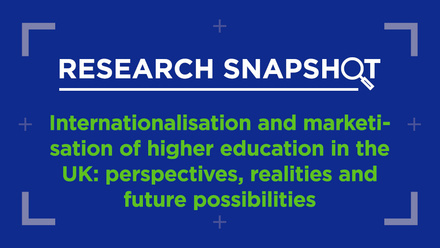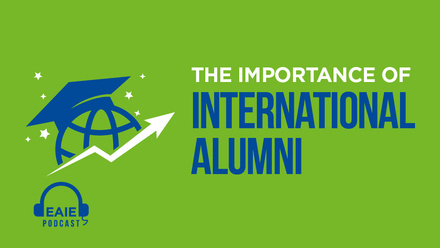3 questions to ask before engaging alumni in virtual marketing and recruitment

These days, marketing and recruitment professionals are no strangers to uncertainty. For many of us, the COVID-19 rollercoaster ride is still ongoing, and although we’re getting better at navigating the twists and turns, we still need someone’s hand to hold through those upside-down loops.
Cue our international alumni ambassadors! These highly-engaged alumni are more accessible than ever before and can support our internationalisation and student recruitment efforts by virtually sharing their global connections, affinities and relationships.
What types of alumni ambassadors can institutions work with, and in what ways can alumni ambassador programmes both support marketing and recruitment agendas and fulfill fundamental goals of creating stronger relationships between students and alumni?
To help inform your plans, consider these three questions.
1) Which markets do you want to reach?
Which international student recruitment markets do you want to reach, and what type of alumni do you want to recruit to be ambassadors? Identify the markets first, as it is important to know if you already have a cohort of highly-engaged alumni from these markets (or who are familiar with these markets) to help with initial efforts. If you don’t have an active group in your chosen markets, then you’ll need to find them. But what type of alumni are you looking for? Given that successful marketers use student personas during the prospect stage, it stands to reason that creating alumni personas is an equally important strategy.
According to Jacqueline Kassteen, marketing and branding expert and founder of Jackfruit Marketing, “Alumni will have different needs and wants over their lifetime, and the value proposition for their involvement and support will change. Moreover, as time passes, alumni can drift further and further away from the university brand, making their student days feel very far away.” This challenge is exacerbated with international alumni, where both time and distance are extreme but, as we’ve witnessed over the last two years, our expectations have shifted to provide as much or more virtual interaction than ever before.
How do you keep alumni engaged throughout the alumni lifecycle so that the pipeline to these ambassadors remains strong? Kassteen stresses that maintaining strong alumni ties starts with effective messaging, which is tailored towards its audience and customised for each alumni persona type and their stage in the journey. “But messaging is a two-way street,” she cautions. “Institutions also want to capture stories from alumni throughout their lifetime to serve different goals.” For example, stories from recent graduates can be aimed at prospective students who will aspire to ‘be like them.’ Meanwhile, by sharing the experiences of alumni who are making an impact through volunteerism during the pandemic, institutions may inspire less-engaged alumni to become involved.
2) How will you keep alumni ambassadors involved?
After considering the types of alumni you want to engage as ambassadors, how do you keep them involved, and what other investments are required to develop a sustainable programme? Institutions must continue to seek to understand what these highly-engaged volunteers value about their relationship to their alma mater and what an ideal reciprocal relationship between themselves and the institution looks like. It is easy to recognise how programmes can help build institutional reputation and recruit new students, but we need to understand how alumni ambassadors feel their personal connections, impressions and recommendations can have the most efficacy in our challenging environment. In other words, do your research and spend time getting to know your alumni today.
Build in an alumni-centric approach to the programme design as you consider how you develop your volunteer framework (eg, recruitment, training, recognition/incentives, sustainability and assessment). For example, provide busy alumni the independence to create their stories through vlogs which can be uploaded 24/7 and quickly assessed and curated for fast turnaround.
Additionally, remain transparent throughout the process by sharing analytics with ambassadors to ensure they understand the impact of their contributions and to improve the experience for all involved. Don’t forget to tag alumni when sharing their stories on social media so that they can continue to engage with your brand as well as respond to the comments received from others in your social communities.
3) Who else needs to be involved?
Wherever your professional responsibilities lie, who else needs to be involved in these fundamental conversations? A solid foundation must be laid before anything else is done, and that requires strong relationships. It is important – and strategic – to establish a relationship with your students before they officially become alumni. Informed and engaged students are more willing to respond to your requests and participate in activities and events.
If an international alumni organisation doesn’t exist, you can start building one with relatively simple means, but this will require internal partners. Involve colleagues from the international students’ office, careers/employability areas and registrars to gain access to contact information for existing students. Extend the conversation to information technology as well as communications and marketing. Programme managers, professors and course coordinators are also key partners as they usually have access to information on students and contact with them even after graduation.
These questions are tips from lessons learnt over the years and a desire to embrace virtual modes when involving alumni in virtual student recruitment activities. Remember, busy alumni will respond when it is easy to participate. In a way, alumni will expect universities to have some form of digital programmes and processes to manage their involvement, even if the initiatives are pilot initiatives.
To summarise: know your markets, know which alumni you want to engage, eliminate barriers to entry, and continue to emphasise relationship building. And don’t forget to enjoy the ride along the way!






